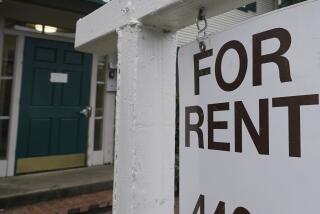YOUR MORTGAGE : Guidelines Aim to Reduce Loan Discrimination
- Share via
WASHINGTON — Large numbers of minority and other mortgage applicants may get a fairer shot at obtaining a home loan this year, thanks to new guidelines to lenders from the federal government.
But lawyers and mortgage lenders warn that the reverse might occur as well: Some minority and non-minority applicants could be rejected out of hand--or pay higher than necessary loan fees--as an unintended result of the anti-discrimination rules.
Why? Here’s a quick update on the not-always-so-simple rules of equal opportunity home lending:
Earlier this month 10 federal financial regulatory and housing agencies released long-awaited guidance to mortgage lenders on how to avoid illegal discrimination. The 22-page statement sought to cover lenders’ most frequent questions about what they can and cannot do under fair housing and equal credit opportunity statutes.
It started with the basic prohibitions. Under federal law, mortgage applicants cannot be discriminated against on the grounds of race, religion, national origin, sex, marital status, age or disability. Just about everybody knows that.
But what constitutes “discrimination?” Lenders cannot on the basis of race, sex, creed, etc.:
--Provide different information or services regarding application procedures, lending standards or credit availability;
--Vary the terms of their mortgage credit, whether interest rate, fees, size, length or type of loan;
--Subtly discourage or encourage borrowers to inquire or apply for a loan.
Nor can mortgage lenders discriminate against a borrower because of the “present or prospective occupants of the area where the property to be financed is located.”
Lenders violate the law whenever they provide “disparate treatment” to applicants--especially in regard to those whose credit histories and incomes rank them as “marginal,” not squeaky clean but not clearly unqualified for a loan either. It’s in situations like this, according to the federal agencies, that even the most subtle differences in approach by the lending officer can make a huge difference.
“Whether or not an applicant qualifies,” said the policy statement, “may depend on the level of assistance the lender provides in preparing an application. The lender may, for example, propose solutions to problems (of credit, income, expense ratios) on an application . . . and provide encouragement to the applicant.”
In other words, if a loan officer offers helpful suggestions to marginal borrowers who are white, but intentionally or unintentionally offers little or no help to marginal applicants who are African Americans, that’s illegal discrimination.
But mortgage companies may also discriminate by virtue of seemingly innocuous loan policies that nonetheless have a “disparate impact.” That is, they have a sharply more negative effect on one group of potential applicants than another--whether intentionally or not.
For instance, a mortgage company that prefers not to make loans below some set figure--say, $50,000 or even $100,000--may be violating federal law. That’s because the effect of its policy is to discourage loans in areas with lower-cost real estate, which in its market area happen to be predominantly minority.
The new federal guidelines do not absolutely rule out minimum loan size policies. But they warn lenders that they will need to have a solid “business necessity” to justify their continued use of such a standard. Translation: Unless you want trouble with the feds, forget minimum loan amounts. Or keep them as low as you can possibly go.
For the record, major mortgage lenders and their trade associations welcomed the new federal interpretations. But in private discussions, some lenders questioned whether the rules might be counterproductive in certain situations. One mortgage executive, who asked that he not be identified, said that the government’s heavy focus on “disparate” treatment of marginal applicants could lead his firm to a totally new policy: Don’t bother with any marginal borrowers. Reject them all.
“If (government regulators) are going to be counting to see whether we approve more loans to white applicants who are borderline (credit risks) versus minorities,” he said, “maybe it’s not worth the legal risk (to consider any applicant who’s borderline). If we turn down everybody who’s marginal, then by definition we won’t be discriminating against any particular group.”
Legal experts active in the mortgage industry agreed the guidelines could have unintended side effects. Washington attorney Laurence E. Platt of Brownstein Zeidman & Lore, cited the prohibition against “disparate treatment” on mortgage rates and fees as an example. Many lenders traditionally have been open to competitive negotiations on their loan quotes and fees with knowledgeable applicants, or they maintain sliding scales of rates and “points” keyed to factors such as borrower credit ratings. (A point equals 1% of the loan amount.)
But if they fear federal attack on their system of pricing, says Platt, “they may play it safe and be less open” to loan pricing variations or negotiated rates. If so, the bottom line for some borrowers--whatever their race, creed or color--could be higher costs at closing.
More to Read
Inside the business of entertainment
The Wide Shot brings you news, analysis and insights on everything from streaming wars to production — and what it all means for the future.
You may occasionally receive promotional content from the Los Angeles Times.










